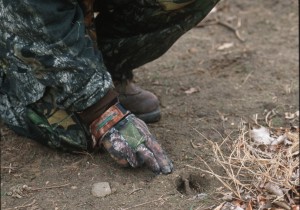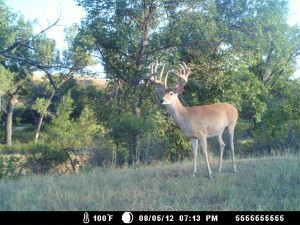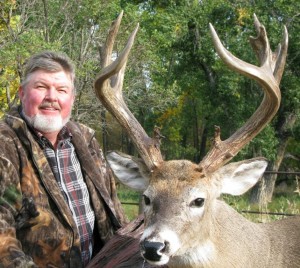 To tie your tag to a big whitetail in 2021, the advance work you do right now is as important, maybe more so, as the hunt tactics you’ll employ in a few of months. Here’s your 5-step plan.
To tie your tag to a big whitetail in 2021, the advance work you do right now is as important, maybe more so, as the hunt tactics you’ll employ in a few of months. Here’s your 5-step plan.
Chart a Course
With the A/C cranking in your house or truck, check topo and aerial maps, either old-school paper ones or on an app like Onx Hunt, of the lands you’ll hunt this fall. Study the contours of crop fields, pastures and woodland edges. Key on timber strips, draws, creeks and similar funnels that connect potential feeding and bedding areas of deer.
Scan the maps and visualize the likely patterns of bucks. If you’ve hunted a property before think back to how animals fed, traveled and bedded according to prevailing winds. By reading and studying maps you can eliminate some 60 percent of marginal deer habitat before you ever leave the house. Then focus your scouting in the 40 percent where you’re most apt to get on a good buck.
Go Bachelor Clubbing
Evenings in late July and August, drive to a hunting area and park where you can see a good piece, or if you have to sneak to a hill that overlooks fields of alfalfa, soybeans or clover. In a more contiguous woods habitat, set up with a partial view of clear-cuts, power lines and other openings in the timber.
Once you’ve found a good vantage, go to work with a 10X binocular and a spotting scope. Buy and use the best optics you can afford. Then put that glass to work looking for velvet-racked bucks that gather to feed and posture out in the open at dusk.
You’re apt to see a gang 3 to 8 bucks hanging out together in mid-summer is typical. Spot 2 or 3 groups of boys in various fields in and around your hunting spot, and you’ll get a good idea of the “buck inventory” in your area this year.
Come late August to mid-September, some of the bucks within a group might begin to move a mile or more to fall and winter range, but other bucks will hang tight in the core areas where you spot them now.
Take a Hike
Until now, your scouting has been long-range and low-impact, but I’m a firm believer that you also need to dive in and do a little ground pounding, especially if you’ll be on a new property this fall. You’ll bump some deer and a few bucks, but who cares? The deer will forget about your intrusion long before the season opens in a couple months.
Take a few days to ground scout over the next few weeks. Tuck your pants into knee-high boots, lather on bug dope, spray down with scent killer and go.
First thing, hone in on food and cover that will be available to deer from September on throughout the season. Biologists say that in late summer whitetail deer are genetically programmed to set up their home ranges near nutritious food sources and with heavy bedding cover close by. Bucks can pile on the pounds (up to 20 percent of their body weight now through September) while moving short distances.
Finding deer and shooter bucks now is all about zeroing in on the best food sources. The Big 4: alfalfa, soybeans, clover, corn. If you have any of these fields on your land or planted nearby on neighboring properties, you will have bucks in your woods to hunt.
Also, roam ridges and bottoms, and point your binoculars into the tops of oak trees. Do you see bunches of green nuts near the branch tips? Or are the limbs sparse?
A big crop of acorns come September will draw and concentrate deer in the timber, so your hottest stands will likely be on ridges and in oak bottoms. Conversely, a lack of nuts and a poor mast year will scatter deer as they move around and seek other food choices; you’ll generally do better to hunt the edges of bean and corn fields, and browse thickets where does and bucks browse.
As you hike around, note pockets and strips of greenery, saplings, briers and weeds in proximity to the feed. Biologists denote security cover as “vegetation thick enough to hide 90% of a deer at a distance of 200 yards or less.” Stand back and look for thickets that fit the bill.
Walk field edges, creek bottoms, strips of woods and other funnels that look good on your maps. Look for main and secondary deer trails, and especially spots where they converge and cross water. Food and cover conditions will change as summer turns to fall, but some deer will use those trails and funnels from now to October and even through the rut.
It’s too early to find fresh rubs, but be on the lookout for scarred trees that bucks blazed last fall or 2 years ago. In a study in Michigan, a herd of whitetails was totally removed from a large enclosure, and no deer inhabited the joint for 3 years. The fourth year, deer were restocked into the pen and immediately began blazing the same trees that their predecessors rubbed years ago! Pinpoint clusters of old rubs and plan to hunt nearby because some bucks will travel in the vicinity of those old rubs this fall.
As you walk, look for and flag strategic trees in various corners of a property where you’ll want to hang a stand in a month or so. Or go ahead and set a stand or two on a ridge or in a creek bottom where your gut says bucks will travel in 3 or 4 months.
Summer Cam Strategy
I’ve had a few cameras running since June on my Virginia properties, but mid-July, when the bucks’ racks are on fire and growing fast, is when I really get serious.
Here’s a typical cam strategy for an 800-acre farm I hunt. On a hike next week, I’ll set 2 cameras on 2 half-acre clover plots we’ve hidden back in the woods. I’ll put 2 or 3 more cams on the edges of larger plots and a corn field, strapped to trees along prominent deer trails that wend out of the woods and thickets.
I’ll wind up by placing a cam or 2 in a creek bottom and near a beaver pond located back in the woods with good security cover nearby.
After a few weeks of checking images and tweaking setups, I’ll zero in on the field corners, edges and ridges where a shooter buck or two are feeding and traveling to bed. Although this intel will reveal their summer habits, the deer will be on a similar pattern when bow season opens, and some bucks will hang in the nearby woods all fall.
Play the Long Game
One summer my friend Eliot spotted a particularly big 10-pointer roaming his ranch along the Milk River in northeast Montana. The buck traveled a primary core area of about 200 acres throughout July and August. He was very visible as he browsed in an irrigated alfalfa field on dusky evenings, then sneaked back to a field of standing corn to bed for the night.
The deer continued this pattern into the bow season in September, passing close to Elliot’s tree stand several times, always just tad too dark and late for a shot.
As the season progressed, the buck’s pattern changed, and he became less visible and more unpredictable. He would spend a week or 2 in sub-core areas a half-mile away as food sources and weather patterns changed.
But ultimately the buck came back to his primary lair where he felt most at home and comfortable. Elliot figured the deer would do that and he was ready.
On the second day of November, 51 days after he’d first spotted the 10-pointer back in July, Elliott spotted the buck coming and stood up in his stand. The pre-rut was kicking now, and the buck was a lot less cautious. My buddy lanced him in the alfalfa with 40 minutes of shooting light to spare.
Lesson of the story: Scouting early and often in July and August pays off, even if you don’t connect on a good buck during the first weeks of archery season. As summer fades to fall, you might spot your target buck only a few times or “lose” him altogether for weeks or even months. But the onset of the rut will often bring a mature deer back to his home core area, back to familiar ground where you spotted him earlier in the summer. Be there and be ready.







